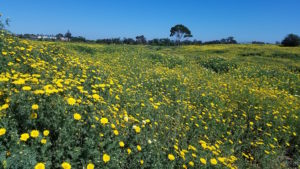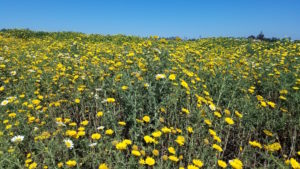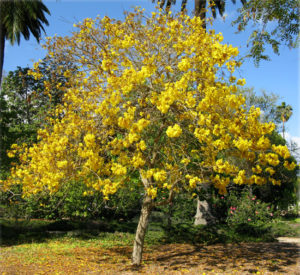I receive inquiries about tree failures from attorneys, insurers, HOA’s, commercial and residential property owners. Unfortunately, many inquiries concern a failure that already occurred, resulting in personal injury, property damage or both. Potential legal clients want to know the cause of the failure and whether the Owner or contractor satisfied the standard of care.
Forensic investigation to determine the cause of a tree failure may be difficult. Whether a limb or whole tree failure, the tree is usually removed and the accident site cleaned in a short period of time. Without actual evidence of the failed part to examine, determining the cause of the failure is impossible. Or is it?
If the Client took effective photographs of the tree failure at the time of the accident or shortly thereafter, a skilled arborist might be able to examine the failure for clues that could determine it’s cause. Unfortunately, most people take pictures that have limited or no value for forensic analysis.

Failure due to root disease. (Photo by JoeLaForest)
There are several types of failures to distinguish.
Root failures, usually due to a root rotting fungus, resulting in loss of anchorage, entire tree failure may occur, particularly during inclement weather. Blackened broken off roots may protrude out of grade.
Soil failure, the entire root ball rotates or heaves out of grade, typically occurs during wet, windy weather. In a soil failure, root protrusion from the soil mass is limited.
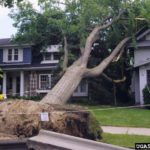
Soil failure resulted in tree loss.
Collar and basal stem injuries may result in the tree snapping off at the base. Collar injuries may occur from mechanical sources, such as string trimmers, mowers, or edgers. Trees grown in small, confined planters, such as cutouts in sidewalk may develop girdling roots resulting in poor root development and anchorage.
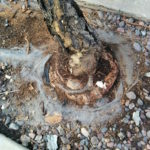
Restricted root zone results in collar failures
Within five years, tree trunk diameter may outgrow the opening within a tree grate. Construction activities that raise or lower the grade may also damage the root collar and surrounding surface roots.
Trunk failures may occur due to co-dominant trunks, two trunks of equal size sharing the same attachment. Co-dominant trunks may develop included bark, which weakens the trunk attachment, resulting in the trunk cracking or completing splitting apart along the weakened plane of included bark.

Co-dominant stems crack. (by Cherokee Tree Care).
Limb failures are perhaps the most common type of failure. Limbs may drop for a number of reasons. Typically, limbs fail due to weak attachments to the other larger limbs or the trunk. Multiple limbs attached at the same point, poor architecture, excess load, cracks, and cankers inevitably start to decay. As the decay decreases the structural stability of the attachment, the limb is susceptible to breakage or detachment from the tree, typically during inclement weather events.
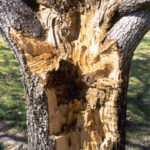
Weak limb attachments. (by Randy Cyr)
However, sudden and summer limb drop are syndromes whereby healthy limb failure occurs during calm weather, usually May-October. The syndrome is still not fully understood or how to manage.
Although not a tree failure, surface roots may be responsible for damaging infrastructure, particularly lifting and cracking concrete sidewalks and patios, a major source of trip, slip and fall accidents.

Roots lifted sidewalk
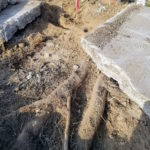
Sidewalk replacement due to root damage
As roots age, they increase in diameter, just like a branch or trunk. As roots grow under a sidewalk age, they increase in diameter, slowing lifting sidewalk panels over time.
Trees typically fail suddenly,with little warning. The resulting impact may cause extraordinary property damage and possible personal injury or death. When an event occurs, emergency workers, media and the public are focused on the event, saving life or restoring traffic, not on taking forensic photographs of the accident.

Emergency crews at work. (by SD Union Tribune)
Forensic reconstruction of a tree failure relies upon factual evidence. If the failed tree or limb has been disposed, it is impossible to assess why the failure occurred unless well taken photographs exist. If a tree limb fell due to a cavity or defect, photographs showing the limb lying on the ground are of limited value.
Forensic photographs should depict the condition of the failed limb or whole tree. While a photo of the limb lying on the ground adds some context, it does not depict the cause of the failure.

Limb failed due to an old decaying canker.
Photographs should show the end of limb that broke off the tree and the scar or injury left on the tree trunk. Sometimes, it takes a long time for a limb canker to decay. Over time, the decay weakens the attachment of the limb which eventually fails. A photo showing the broken end of the limb and the damaged trunk area could prove invaluable.
Considerations for effective forensic tree failure photographs:
- Timing:
- Take as soon as possible from date of the accident.
- Take photographs of changes in condition, ie: the tree stump remained one day but was removed a week later.
- If case extends over time, take photographs over the time period, this may help establish original tree wounds and healing rate.
- If using a digital device, turn on the date stamp for photographs.
- Include Photographs of The Site:
- Establish the overall accident perspective with wide angle photographs depicting the entire site, street, park etc.
- Overhead or underground utilities, adjacent structures, construction activity.
- The presence of irrigation system.
- Damp, wet, moist, standing water conditions.
- Planter size, confined by curb, gutter, sidewalks, asphalt paving, driveways or other obstructions.
- Grade condition, accumulation of tree litter, mulch or compost placed around tree trunk and roots.
- Add a tape measure for scale
- Include Photographs of the Subject Tree or Part:
- The entire tree or limb from one end to the other.
- Surrounding trees of same species for comparison.
- The broken end of the limb
- The torn, damaged area on the trunk the limb detached from.
- The root condition.
- The planter or turf area the tree was growing within.
- The soil conditions.
- Add tape measurements for scale and dimensions.
Tree failures occur infrequently, but when a failure occurs, consequences may be severe. The first reaction of emergency responders and the general public is to assist in an emergency, not document the cause. Since most tree failures are cleaned up and removed within a short period of time after the accident, valuable forensic evidence may be lost.
Photographs shown in this blog show the location of the failure, not the end result of the failure. Effective forensic photography should depict the failed tree component(s), including trunk scars, injuries, failed or torn limb ends. Tape measurements included in the photograph may prove very helpful.
When the tree or limb has been cut up and hauled to the landfill, the only effective evidence might be photographs taken at the time of the accident that depict defects that might establish the cause of a failure. An arborists requires evidence and facts to assess why a tree failed. Well taken photographs are often the most effective forensic tool available for analysis. So, take the right picture!















